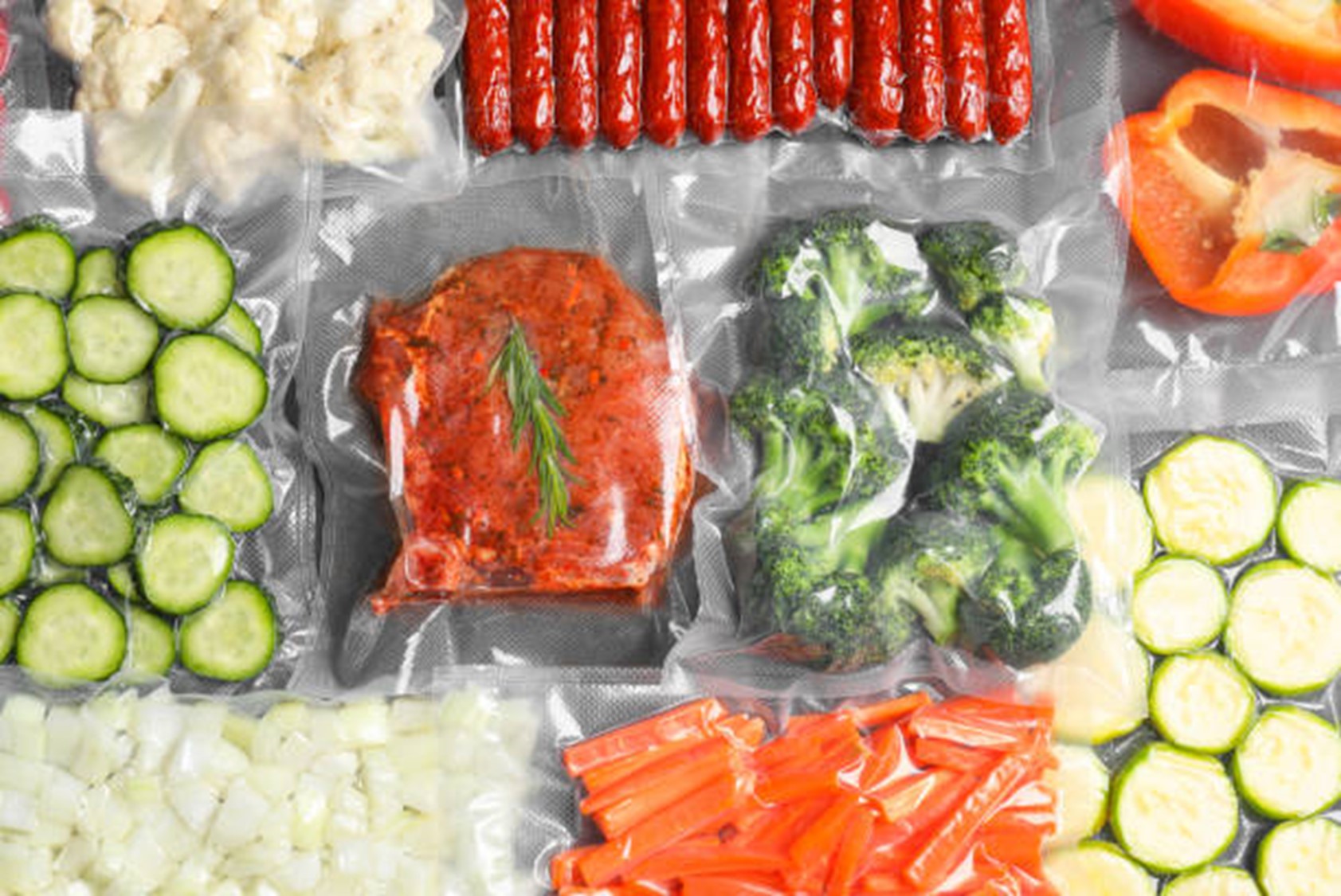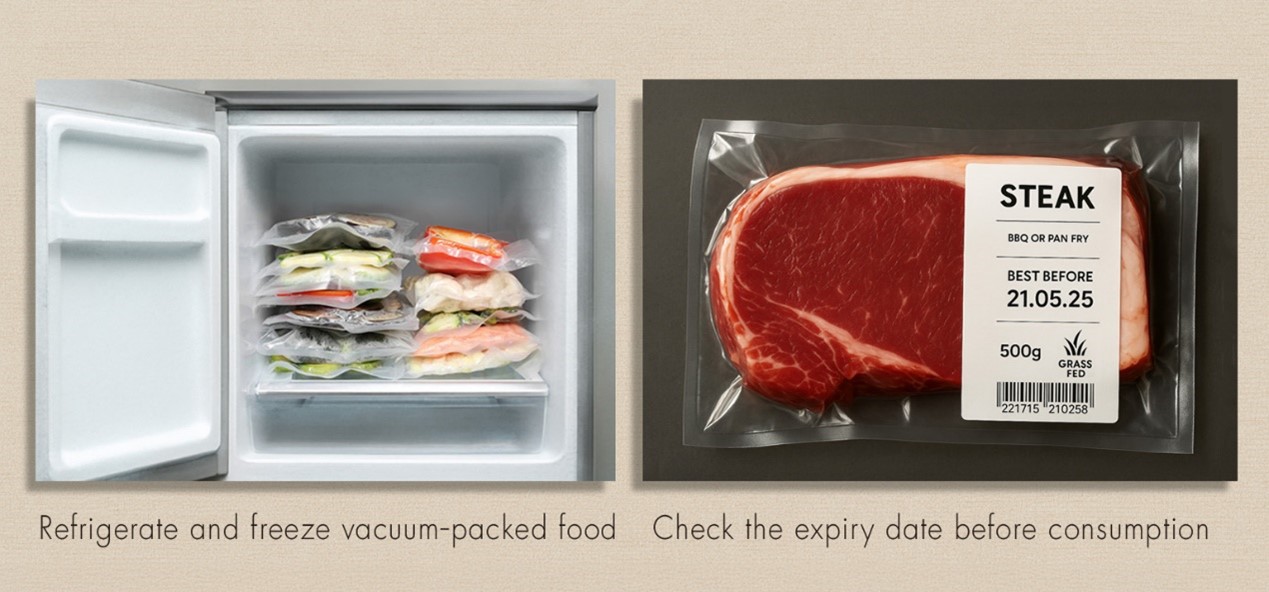
Food Safety Focus (226th Issue, May 2025) – Article 2
Vacuum Packaging – Keep Food Airtight and Safe
Reported by Mr. Kenneth YIP, Scientific Officer
Risk Communication Section, Centre for Food Safety
Vacuum packaging has become ubiquitous in today’s food industry since 1950s. This method offers a fast and efficient way to preserve food by sealing it into packets, reducing freezer burn, preventing odour transfer, enabling packaging and portioning of many food types and extending shelf-life while reducing wastage through decreased spoilage. It is used by both commercial producers and domestic users. This article will examine the science behind vacuum packaging for food preservation, its synergistic effects with other food processing methods, and key storage considerations for vacuum packed food.
Why is Vacuum Packaging Widely Adopted?
Vacuum packaging prolongs the shelf life of food by removing air, especially oxygen, around the food in the package, which is commonly achieved by vacuum pumps. This food preservation method is versatile, applicable to a wide range of food including raw, cooked and ready-to-eat ones. The reduced-oxygen (anaerobic) environment slows down the growth of most microorganisms present in food and hence reduces the rate of deterioration. Besides, the airtight sealed packages prevent atmospheric air and water vapour from contacting the food surface, thus reducing the risk of contamination.
One major benefit is that vacuum packaging retains food in its natural state including juices, sauces, flavour and freshness without the use of chemical preservatives. Chemical preservatives may alter the texture or taste of the food. However, some food likes fresh meat may undergo colour changes due to the absence of oxygen as natural pigments like myoglobin in meat will turn from bright red to purple red in vacuum conditions. While this may affect the appearance, it poses no food safety concern, and the original colour returns upon contact with air.

Figure 1: Some vacuum packed food examples
Synergy of Vacuum Packaging with Other Food Processing Methods
While vacuum packaging can be used as a single means to preserve food, it is often combined with other preparation and preservation methods to achieve optimal results. Sous vide is a method of cooking vacuum-packaged products such as raw beef and fish at temperatures usually from 47°C - 88°C, and with the heating time ranges from 2 to 48 hours. The vacuum pack plays an important role in preserving sous vide food by establishing a physical barrier to avoid contamination from the surroundings to the food in which its water content and nutrients could favour the bacterial growth in the Temperature Danger Zone.
Dehydration and freeze drying are common food preservation methods by decreasing the moisture of food like cereals, fruits and vegetables to low levels. As dehydrated food has lower water content than fresh varieties, bacterial and fungal growth become unfavourable. Vacuum packing complements these methods by preventing re-absorption of moisture in the dehydrated food, further extending the shelf life of these foods.
Vacuum-Packed Foods are Not Sterile and Should be Stored Properly
Some believe that food kept in vacuum is safe irrespective to the storage temperature. However, while vacuum packaging protects food from external contaminants and limits oxygen exposure, thereby slowing microbial growth, it is definitely not a sterilisation method. Therefore, additional food preservation methods including refrigeration or freezing may be required. Although most aerobic microorganisms cannot thrive without oxygen, certain anaerobic pathogens, such as Clostridium botulinum and Listeria monocytogenes, can still survive and pose risks. For example, hot smoked fish and fresh chilled pasta have been reported to have Clostridium botulinum even when vacuum packed, whereas Listeria monocytogenes has been found in vacuum-packed smoked fish products. If a shelf-stable food product is desired, canning (in jars, cans or retort pouches) is required. The food is subject to adequate heat treatment such as processing with steam under pressure during canning, which destroys bacteria and spores and ensures long term food safety without refrigeration.

Figure 2: Properly store and check labels of vacuum-packed food before consumption
Vacuum-packed food should be stored at proper safe temperatures according to manufacturers’ instructions as listed on the food labels like refrigeration at 4oC or below and freezing at -18oC or below, and their expiry dates should be checked before consumption. Damaged packaging increases the risk of environmental contamination and spoilage, even for vacuum-sealed products. When in doubt about a package's condition, it would be safest to discard the product.

